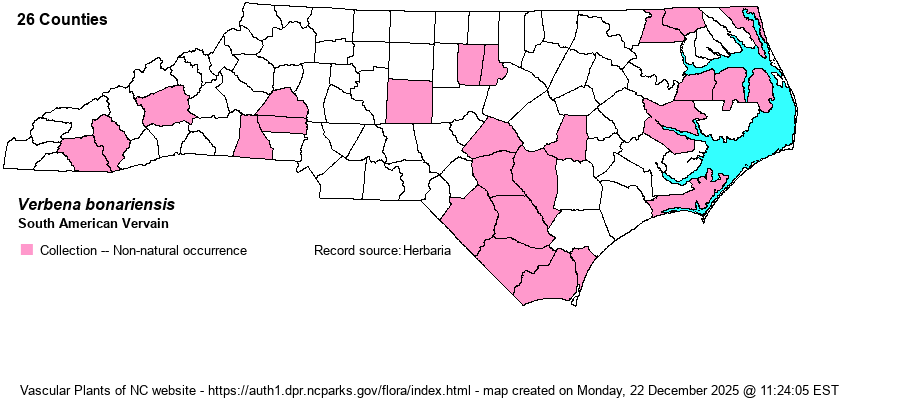| Author | L. | |
| Distribution | Scattered across the state, with a concentration in the southern Coastal Plain. Other specimens from Dare, Gaston, Jackson, and New Hanover counties are actually V. brasiliensis. However, with the recent splitting out of V. incompta from it, the range as mapped below might be overstated.
Native of South America; in N.A. NC to GA -- as mapped by BONAP and Weakley (2018), but this is probably incomplete. | |
| Abundance | Perhaps uncommon to locally fairly common in the Coastal Plain; rare to uncommon in the Piedmont and Mountains. However, some or many of these records and thus part of this abundance may refer to V. incompta. | |
| Habitat | Dry to moist soils of roadsides, fields, pastures, greenway trailside, edge of artificial pond, disturbed places. | |
| Phenology | Flowering and fruiting May-October. | |
| Identification | Purpletop Vervain is a tall 1-few-stemmed plant to 7 feet, though typically reaching about 4-5 feet tall. The stem leaves are sessile and clasp the stem (vs. tapered to the base and not clasping in V. brasiliensis), sharply toothed, and lance-shaped. The inflorescence consists of terminal and axillary shoots with flat-topped clusters of short spikes. These spikes have many tiny rich magenta to purple flowers. V. brasiliensis also differs in its shorter corolla tubes, and its smaller flowers are mostly lavender -- not as striking in bloom as is V. bonariensis. To differentiate it from V. incompta, see that species account. Note: in a couple of specimens of V. bonariensis at NCU, the inflorescence clusters are modified into a semi-globular shape--very distinct! | |
| Taxonomic Comments | In recent years, V. incompta has been described and pulled out of this species.
| |
| Other Common Name(s) | | |
| State Rank | SE | |
| Global Rank | GNR | |
| State Status | | |
| US Status | | |
| USACE-agcp | FAC link |
| USACE-emp | FAC link |

